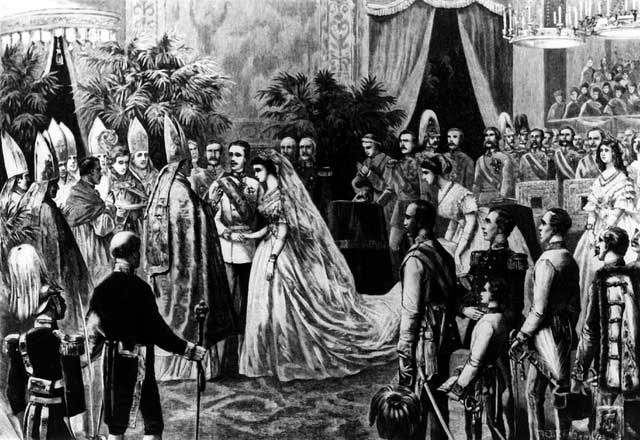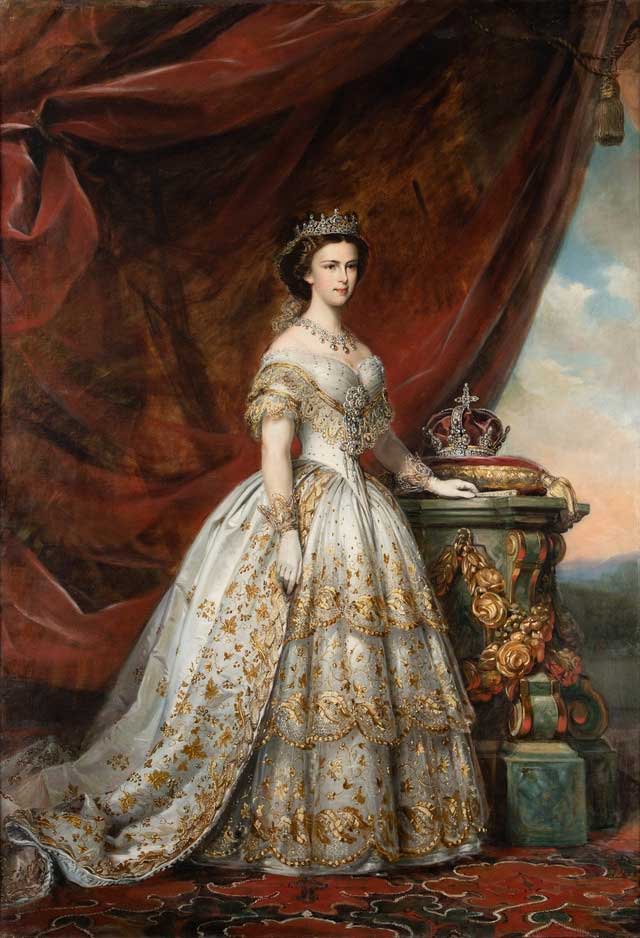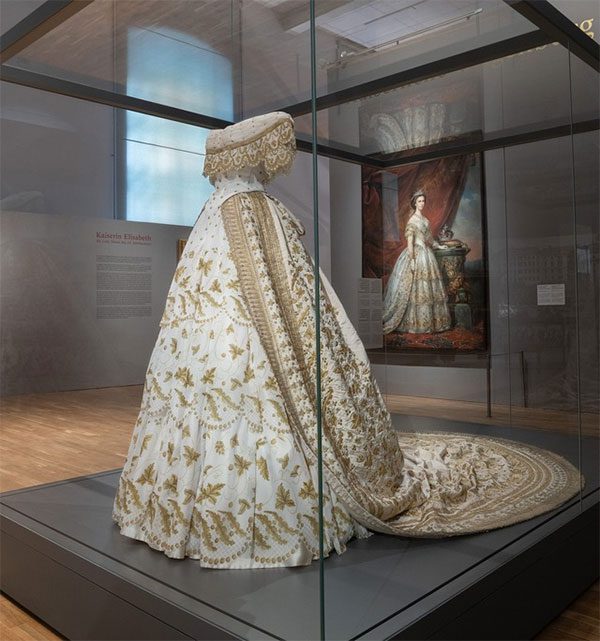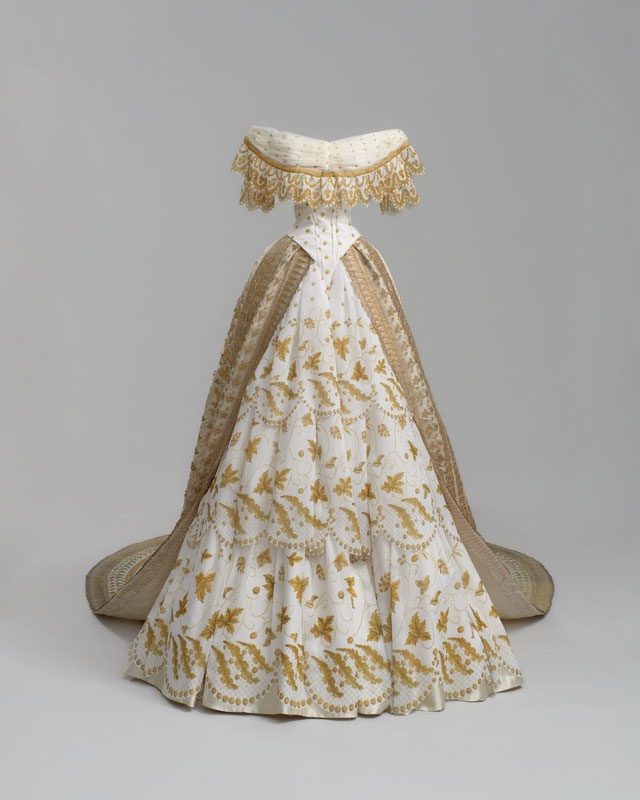This dress went missing right after Elisabeth’s wedding and has been sought after by royal history researchers for decades.
After the release of “The Empress”, a German television series produced in 2022 about the life of Empress Elisabeth of Austria, the wedding dress of the main character became famous. However, few people know that this dress disappeared right after Elisabeth’s wedding and has been a mystery for nearly 200 years.
In 1854, after Empress Elisabeth of Austria married Emperor Franz Joseph in Vienna, her wedding dress vanished.

Image believed to be of Empress Sisi’s wedding.
Affectionately known as Sisi, this empress has long been quite famous in Europe. Her rebellious personality has been vividly depicted in films such as Corsage (produced in 2022) and especially in the hit Netflix series “The Empress.”
However, despite her popularity, Empress Sisi’s wedding dress has remained a mystery for nearly 200 years.
Now, thanks to a series of clues, Austrian researcher Dr. Monica Kurzel-Runtscheiner has been able to partially unravel the mystery of this classic attire.
The reason why all information about the dress has not been disclosed is that journalists, artists, or anyone capable of documenting activities during the wedding were not allowed to attend the event by the Austrian royal family at that time.

A newly discovered portrait showing Empress Sisi in an unseen dress.
There are no confirmed images or detailed descriptions of the dress, making it an enigma. The only remaining hint is the train of the dress, designed with incredibly luxurious material, which is currently on display at the Imperial Carriage Museum in Vienna, under the directorship of Dr. Kurzel-Runtscheiner.
Dr. Kurzel-Runtscheiner, nicknamed the “treasure hunter of lost items,” has spent years investigating Empress Sisi’s wedding dress. She has “scoured” libraries for answers but met with little luck.
However, in 2021, Dr. Kurzel-Runtscheiner received a message from a stranger, a woman and freelance researcher from Spain named Silvia Santibañez.
In that message, Silvia Santibañez mentioned that she had found a little-known portrait of Elisabeth painted in 1857 at the Silesian Museum in Opava, Czech Republic.
In this painting, Sisi is wearing a wedding dress, and the train of this dress closely resembles the one preserved at the Imperial Carriage Museum.
“I was thrilled,” Dr. Kurzel-Runtscheiner said. “Finally, I have evidence that Sisi actually wore the dress we have at the time of her wedding. Moreover, it shows what the overall dress looked like, something we could only speculate about before.”

A handcrafted replica showing Empress Sisi’s wedding dress, displayed next to her portrait.
Dr. Kurzel-Runtscheiner spent months decoding this painting to confirm whether it truly depicted Sisi’s mysterious dress.
Through her observations, Kurzel discovered that the 1857 portrait of the Austrian Empress was unusual for two reasons.
First, it was painted three years after the wedding took place.
Second, it was not painted by an artist who had worked for or understood the Austrian royal family, but by an anonymous artist named Joseph Neugebauer.
This might lead some to believe that the painting is not authentic. However, Dr. Kurzel-Runtscheiner noted, “What he depicted about the dress, in detail, makes me certain he must have seen it.”
Therefore, Kurzel did not stop there; she wanted to ensure that everyone could know the truth about the dress, even if only a little. Thus, Kurzel established a project and set out to find the final answers.

First, she traveled to the Silesian Museum with some photographers to capture the 1857 portrait with high-resolution cameras. Then, the graphic designers at her Imperial Carriage Museum used those images, along with the existing train, to create an illustrated design draft of Empress Sisi’s wedding dress.
After months of work, Kurzel’s team found someone who could print the fabric design, a man in Bavaria, Germany, who owns a small printing shop. They exchanged samples between Vienna and Bavaria until the fabric print was nearly perfect.
However, the project faced a setback when the printer in Germany fell seriously ill and had to cancel the contract. Kurzel’s alternative was to bring the fabric to a conservator in Vienna, who created a full-scale replica of the dress herself.
The dress, modeled alongside the 1857 portrait of Sisi, was displayed at the Imperial Carriage Museum until November 5.
This was the first time the public could see two parallel versions of the dress that Kurzel believes is the long-lost wedding dress of the Empress of Austria.
According to Maura Hametz, a history professor at James Madison University in Virginia, and co-author of “The World of Sisi: Empress Elisabeth in Memory and Legend,” all the mysteries surrounding the dress have been clarified at a perfect time.
The story of Sisi has gained popularity from the Netflix series “The Empress,” which has proven quite successful with a second season being produced shortly thereafter.
However, even though the project to unravel the mystery of Empress Elisabeth’s dress has achieved certain results, Dr. Kurzel-Runtscheiner insists that her work is not finished.
She stated that her next plan is for her team to visit monasteries in Hungary and Bavaria to study artifacts believed to be related to this wedding dress.


















































